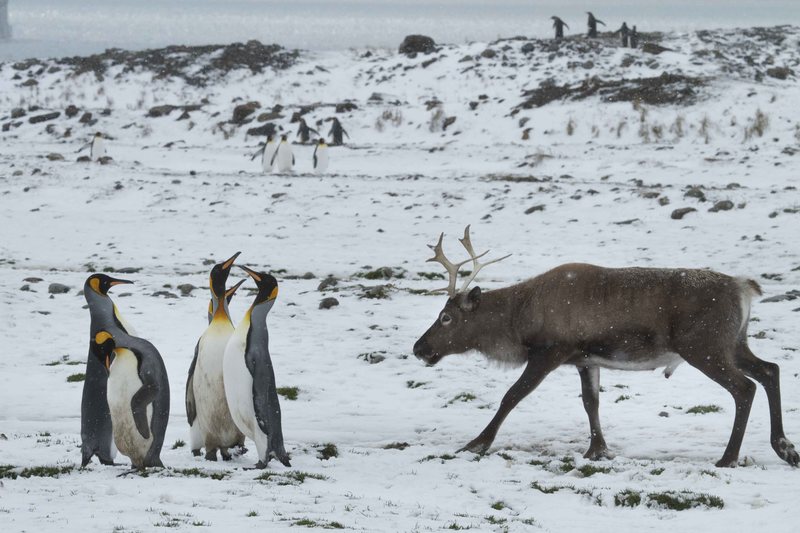
No introduced mammals live on the Antarctic Continent today, although that could change in the future. However, a variety of animals have been introduced onto some of the sub-Antarctic Islands in the past, including chickens, rats, sheep, pigs, reindeer, mice, cats, rabbits and cattle. Remnants of some of these animals still survive, and thrive.
Crazily, some members of the early expeditions even considered introducing foxes onto the Antarctic mainland with the idea of carrying out a bit of fox-hunting with hounds and on horseback. Tally-ho!!. Luckily no-one acted on this strange idea.
Borchgrevinks ‘Southern Cross’ expedition of 1898-1900 were the first to use sledge dogs in Antarctica but they removed the dogs when they left. This expedition was followed by Scott’s ‘Discovery expedition’ which also used dogs and later by Shackleton’s ‘Nimrod’ expedition using dogs and Mongolian ponies.
Scott would return again with dogs, and ponies as well, in 1910 on his ill-fated ‘Terra Nova’ expedition. The dogs and ponies were used for hauling sledges and for food when things got tough. They utilised 17 ponies during their first year, and were resupplied with seven Indian mules during the following season.
All of these animals either died in Antarctica or were brought back to New Zealand and with Scott’s last expedition we also saw the last use of horses in Antarctica.
Dogs were still being used to haul sledges at a number of Antarctic bases until the last dogs were removed in 1994 as a result of the environmental protocols of the Antarctic Treaty. They were afraid they would pass diseases on to the local populations of wild animals.
Then there is the strange case of Admiral Byrd’s cows. More for a publicity stunt than for any practical reason, Byrd brought three dairy cows with him on his second Antarctic expedition of 1934. A fourth was born on the journey. Though one died, three of them made it back to the US where they were treated as celebrities.
Any of the animals that have thrived in Antarctica have not done so on the mainland due to the cold and lack of vegetation. But the sub-Antarctic islands have provided a more hospitable environment.
Many of the animals either were brought there accidentally by the early whalers, e.g. rats on ships, or introduced for food and hunting e.g. reindeer, rabbits and pigs.
So we ended up with a thriving rat population on South Georgia and rabbits on Macquarie island until they were successfully eradicated; also cattle, rabbits and mice on Enderby Island; cats on various islands; and Reindeer on South Georgia and the Kerguelen Islands;
Sheep were introduced to Campbell Island in the late 1890s, and were effectively culled by the late 1980’s, and cats were introduced to Marion Island but effectively eliminated by the 1990’s.
Unfortunately the removal of the cats led to a massive increase in mice numbers which is an ongoing problem and devastating to young albatross chick numbers. Pigs and goats were introduced to the Auckland Islands as a survival food for shipwrecked sailors but, as usual, they grew out of control and damaged the island ecosystem.
It is not only mammals that are the problem. A total of 359 invertebrates and their remains were found in cargo transported to the Polish Arctowski Station, or caught in the station’s facilities, some of which were pests of cultivation (26%), food pests (43%), wood−destroying pests (4%), and domestic insects and arachnids (spiders) (15%).

Scientists with the British Antarctic Survey (BAS) have discovered that the chironomid midge, a species of fly originally from South Georgia, has flourished since its accidental introduction to Signy Island in the Antarctic in the 1960s.
Its range has now extended 200 metres from its original site, which may not seem like an extensive spread but this is a flightless midge and it has to crawl everywhere, so we are lucky that it can’t fly. In some areas it is more numerous than any of the native insects. Ground beetles in particular have also been extremely invasive, preying on the native insects of these islands and leading in some cases to their local extinction.
Antarctica is the continent least affected by invasive species, but threats from climate change in terms of decreasing ice exposing more land and increasing vegetation as a food source and increasing human activity in the form of tourism, not to mention activities at Antarctic bases, are increasing this threat.
So the battle continues to keep Antarctica free of introduced species and though we have had some impressive wins it seems to be an uphill battle.

